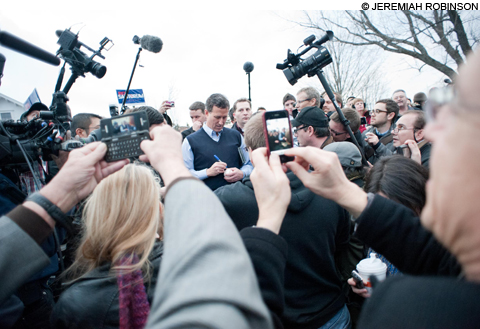
THE GREAT GAME of covering presidential hopefuls like Rick Santorum (above) has changed profoundly, as strapped local papers have stopped sending their own reporters on the campaign trail — and political niche reporters take their places. |
The media mob will have high-tailed it out of New Hampshire by the time you read this. Most will have returned to their hometown newsrooms for a break before parachuting into South Carolina, to see if Mitt Romney can translate his 17-point win into a potentially deal-clinching victory on January 21. The shock troops of the chattering and scribbling classes, however — the handfuls of beat reporters permanently assigned to the campaign trail or to specific candidates — will push on without respite. As they always do.
The great game of covering the egomaniacs who seek the White House seems — on the surface at least — untouched by time. Campaign caravans still disgorge their cargo of bleary-eyed reporters at pre-packaged political events, in a routine immortalized by Timothy Crouse 40 years ago in his iconic study of the campaign trail, The Boys on the Bus. True, the reporters on board are as apt to be girls as boys now; they file from their laptops rather than waiting to get to a typewriter and Telex; and the godsend of smart-phone apps has diminished the grueling boredom of the ride.
Of course, there has been an evolution in political coverage, triggered by the digitization of the news business in which every nanosecond represents yet another news cycle. But something else has changed: the structure of the media business.
In the past, most of the journalists on the campaign bus wrote for local newspapers — small, medium, and large publications from all over the country — that sent their own reporters to cover the candidates.
That practice has sharply diminished, just since the 2008 primaries, in large part due to the economic realities of the industry. Just as newspapers have been forced to close overseas and Washington bureaus, they have trimmed back on their on-the-ground campaign coverage — relying on wire-service reporting, and columnists commenting on what they see and read from afar.
At the same time, there is a huge increase in journalists on the campaign trail covering the election for national, political-niche media. That includes Politico, National Journal, Huffington Post, Yahoo! Politics, Fox News, MSNBC, Real Clear Politics, TPM, Slate, Salon, American Spectator, and Daily Caller.
Instead of the general readership of daily newspapers, these outlets target an audience of political junkies.
Some suspect that the result has been an increased focus on so-called process stories— obsessing over the internal workings and strategies of a campaign, rather than the candidate and the issues.
Others are less leery — some even suggesting that coverage is improving thanks to the fierce competition among these nationally read journalists. But nobody thinks it's going back to the way it was.
CUTBACKSCurtis Wilkie was on his first presidential campaign, reporting for two Wilmington, Delaware, papers, when Crouse immortalized him in The Boys on the Bus. Wilkie, later a Boston Globe reporter and now the Overby Fellow and Kelly G. Cook Chair of Journalism at the University of Mississippi, can still run through a mental checklist of reporters on that 1972 bus; it included writers for dailies in Chicago, Washington, Baltimore, Boston, Philadelphia, Miami, Dallas, San Jose, San Diego, Los Angeles, Seattle, Denver, Minneapolis, and St. Louis — in many cases, with more than one from each city.